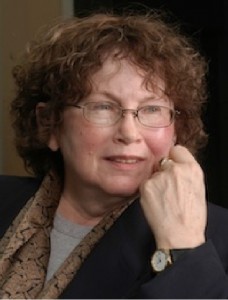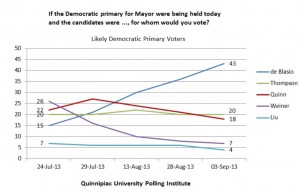Dear Commons Community,
With the primaries fast approaching on September 10, interest in the New York City mayoral race is becoming intense. Anthony Weiner’s sexting issues have provided much fodder for the media as well as an unfortunate distraction for the candidates and the voters. Nevertheless, as the primaries near and the opinion polls become more frequent, the candidates are sharpening their positions on issues in an attempt to distinguish themselves from the competition. There are many issues that need to be reviewed and considered, but education is surely on the minds of voters, especially for parents of school children during this election year.
Republican candidates are supporting most of Mayor Michael Bloomberg’s policies of the past twelve years. The majority of Democratic candidates agree that New York City needs a new direction.
Bloomberg, for the most part has performed his duties well: the business community has confidence in the mayor and the New York City economy has emerged from the recession doing better than most other metropolitan areas of the country; his stance on gun control has been impeccable and inspiring; his initiative for bringing more technology companies to the city is visionary.
However, the mayor has also had his problems–arguably, the most controversial—has been the policy changes he brought to the New York City public school system. While there is no doubt that the school system is better managed under mayoral control than under the previous community school board structure, schooling is not simply about management; it is and must be primarily about learning and education.
Some of his education policies have polarized segments of the City’s population by pitting the school reformers who seek greater privatization, charter schools, testing, undergirded by a corporate culture, against the teachers and unions, ultimately alienating teachers, parents, community groups, and students, alike.
The most visible conflict the Bloomberg Administration advanced has been against the United Federation of Teachers.
Among the mayor’s greatest failings was his appointment of Joel Klein, a non-educator, to be the City’s schools chancellor. Klein created a confrontational environment where teachers were vilified and parental input was ignored. Many of Klein’s perceived accomplishments, advanced by Tweed spin doctors, did not reflect the substandard realities (more than 400 schools received failing to middling grades of F, D, or C on the recent school “report card” evaluation system) that continue to exist in many public schools.
During Klein’s tenure, test scores barely improved. Results on the National Assessment of Educational Progress, which administers a test every two years to fourth- and eighth-graders across the country, show that New York City results have been basically flat with little if any improvement. Graduation rates have improved but college readiness declined, indicative of a system that was simply pushing students through, but not truly educating them. For example, under Klein, the high school graduation rate climbed from 46 percent in 2005 to 65 percent in 2011. All that is to the good and required enormous hard work, however, more than 70 percent of the graduates still fell short of college readiness.
The present chancellor, Dennis Walcott, has toned down the vitriol considerably, but was appointed too late to leave a constructive policy mark on the school system. He also presided over the horrific implementation of the Common Core Curriculum; because it was rushed into New York State public schools, many districts including New York City, were not prepared to develop materials or do the teacher training needed to teach the new curriculum. The results were that just under 30% of New York City students were proficient in math and 26% in reading – a drop by more than half of the number of city students making the grade in each subject compared to 2012. But the real tragedy in these results is in the differences in achievement between black and Hispanic students and their white and Asian counterparts. In math, for instance, 15 percent of black students and 19 percent of Hispanic students were proficient in mathematics, compared with 50 percent of white students and 61 percent of Asian students. These disparities are not due to the Common Core but to the systemic failure of the New York City public schools to improve the education of minority students.
So where does this leave the candidates who hope to succeed Bloomberg?
The Republican candidates (Joseph Lhota, George McDonald, John Catsimatidis) generally support Bloomberg’s education policies and if any of them is elected, New Yorkers can expect more of the same of the past 12 years. Lhota, however, has leveraged his experience as a City University of New York Trustee, to comment regularly on the fact that New York City high school graduates are not ready for college. He frequently mentions that in 2012, 81 percent of the CUNY applicants who graduated from New York City public schools were not ready for college and required remediation classes to enable them to successfully enter academic programs.
If elected, Lhota will likely take a hard, critical look at the present policies, such as credit-recovery (a program that uses various strategies, often involving online class work, that give students, who have failed a course, the chance to “recover” credits that otherwise would be lost) that pushes students through to graduation without necessarily mastering subject matter.
However, within the crowded field of Democratic candidates (Christine Quinn, John Liu, William Thompson, Bill de Blasio, Anthony Weiner, Erick Salgado, and Sal Albanese) many of the candidates have put forward different policy approaches to reforming education in the City. Specifically, Quinn, Liu, Thompson and de Blasio have all criticized Bloomberg education policies. The highlights of their respective positions follow:
- Quinn has stated that the present system views the closure of a public school as an accomplishment, when it should be seen as a failure in effectively solving problems.
- Liu regularly comments that school choice has value, but believes the deck is stacked in favor of the charter schools because these schools enroll fewer English language learners and children with special needs. He would stop the co-locations of charters in public schools.
- De Blasio views student performance as an important aspect of teacher evaluations but notes there has been a corrosive effect on teacher morale due to standardized testing and a curriculum based on test preparation.
- Thompson has characterized public education under Bloomberg as a system where “parents feel shut out, teachers feel demonized,” and “too many classrooms have been turned into test-prep centers.”
So if education is important to New Yorkers and their children: whom should we support and vote for in the mayoral primaries?
The Republican candidates will likely continue Bloomberg policies. Choosing among the four major Democratic candidates requires a more careful analysis. The UFT has endorsed Thompson and he might have the strongest education credentials of all the mayoral candidates, having served on the New York City Board of Education in the 1990s. Liu has done his homework and clearly understands what public education could and should become. De Blasio has delved deeply into education issues. His knowledge and political style enables him to move public education debate forward in a new direction. Christine Quinn has said a lot of the right things but has for the most part been for the status quo, by supporting many, if not most of Bloomberg’s policies.
My position is that Thompson, Liu, or de Blasio would be good for public education in New York City. Liu, however, has a nagging campaign-finance issue that is not going away and will become more of a political problem in a general election, leaving Thompson or de Blasio who both have put forward policies that emphasize teaching, learning and more community and parental involvement in public education. Either of these candidates would move New York City public education in a new and right direction.
Tony







